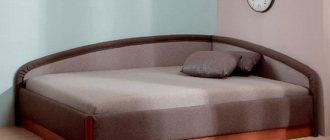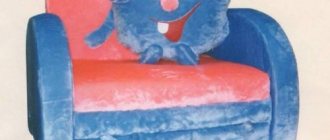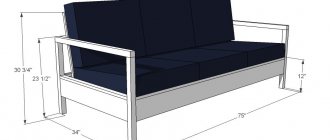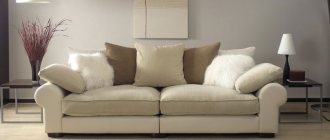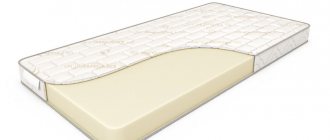Do-it-yourself foam mattress - an interesting and exciting process
Do-it-yourself foam mattress - who might be interested in this topic? First of all, for those who plan to become a professional furniture maker in the future and are already trying themselves in this business. Also for those who want to save on buying a new orthopedic mattress. Making a sleeping item with your own hands eliminates the need to pay for the work - you only have to spend money on materials. And, finally, for those who simply love to tinker, create, are not afraid to take on the unknown and want to understand “how the world works and everything in it”!
DIY foam mattress
Foam rubber (polyurethane foam) is a material ideal for beginners. To create a monoblock foam mattress, you need a minimum knowledge of the technological process and a minimum amount of materials for its creation. In addition, PPU blocks are a relatively affordable product. It is possible to select the block size, desired height, density and hardness.
Selection of foam rubber for a mattress (foam rubber density)
In the modern production of orthopedic mattresses, foam rubber, or as it is also called, polyurethane foam (PPU), is the main filler that ensures the comfort and durability of sleep products. In spring models it insulates the spring block, in springless models it performs load-bearing functions.
Thanks to scientific and technological progress and new technologies, the properties of foam rubber have been significantly improved in recent years. Now this is not the same at all: crumbling, yellowing, quickly losing elasticity, sticking together material, and improved - in some brands literally beyond recognition.
Reference! Foam rubber is soft, elastic polyurethane foam (PPU). The name foam rubber is nothing more than the transition of the name of the trademark (the Norwegian company Porolon, which supplied polyurethane foam to the USSR in Soviet times) into a common noun.
Brands of furniture foam rubber are conventionally divided into 6 categories. PPU marking reads as:
Soft (HS) - not recommended for mattresses.
Standard (ST) , made from a single polyol. The stiffness of a material is determined by its density. Density 35 (ST 3542) is considered suitable for mattresses in the ST category.
Reference! Even with a density of 35 ST, it is not designed for people with heavy weight (optimally up to 80 kg).
Increased rigidity (EL) - reinforced, reinforced polyurethane foam, with the addition of rigidity to the standard polyol. Thanks to this, at the same density, a more rigid material is obtained. An excellent option for a quality mattress is the EL 3245 brand.
Extra hard (HL) . For example, HL 4065 is a brand with high density and rigidity. Durable, reliable, expensive foam rubber for mega-springless, designed to withstand extreme loads in the form of pressure from the weight of very fat people.
Highly elastic (HR) is made from four polyols. The production process is quite labor-intensive, which consequently affects the price. Durable, with greater load-bearing capacity. HR 5535 is a brand that deserves attention - with a service life of up to 15 years.
Reference! Brand HR* 6030 LL - WATERLATTEX - highly elastic, with increased comfort. It feels almost impossible to notice the difference between waterlatex and natural latex.
Viscoelastic (VE) - MEMORY is the latest product in the production of polyurethane foams. Expensive, but the material completely justifies the price. It is considered one of the best due to durability, reliability, quality, and high anatomical effect. The EL 5020 brand has proven itself to be excellent.
Advice! Before you decide to purchase the VE brand, test the properties of the material by lying on it. Although in most cases reviews of the characteristics are enthusiastic, not all 100% of those who have tried it like the enveloping effect.
Preparation of materials and tools
Making a mattress
Below are step-by-step instructions for making the simplest model of a mattress from a PU foam block.
Types by density
The higher its density, the longer the service life will be. By the letter indicators that appear on the label, you can navigate the types of foam rubber. Digital values indicate density indicators (the very first digit), subsequent ones indicate compression stress indicators.
Soft
Foam rubber is suitable for equipping sleeping places (sofas, beds, couches). Its approximate density is from 25 to 45 kg per 1 m3. Good indicators of softness, elasticity, and firmness provide comfort during sleep. There is no feeling of discomfort from sitting or staying in one position for a long time on such a sofa; you can relax in your sleeping place.
Soft material is designated with HS symbols. This marking is affixed to the packaging.
Attention
The product is quite pleasant to the touch, but not durable. You have to constantly repair or completely change the entire canvas.
Standard
Manufactured from a base polyol. It may include additional components to obtain the required strength, density and elasticity. Most often, this type of foam rubber is used for finishing armrests and headrests in upholstered furniture. Density - 25–30 kg per 1 m3.
Advice
To choose a standard foam rubber, you need to find the ST marking on the label, but also focus on the numerical values. They are indicated to show the buyer the density and compression stress.
The standard version is the most common on the market and can be used for restoration or self-assembly. The only and significant disadvantage is its low strength: foam rubber cannot withstand heavy loads. You cannot operate it with increased loads (it will not withstand more than 90 kg).
Hard
Not suitable for filling children's beds. This is a rather unpleasant option for relaxation. But it’s great for people who prefer hard surfaces to soft ones. Density - from 25 to 40 kg per 1m3. Marking: HL mark.
Ideal for sofas that are constantly used for sleeping. It is best to sleep on it rather than use it as a resting place for everyone.
Increased rigidity
Special polyols give increased rigidity to the product. They increase strength many times over, but this indicator depends on the components included in it. Density - 30 kg per 1 m3. An excellent material for making mattresses and sofa coverings. With a higher density value, the furniture can withstand increased loads. Marking - EL.
There is no weight limit. This is a comfortable option for a sound and long sleep. If you put another additional layer of foam rubber on top with increased comfort, the surface will become softer and more comfortable for sleeping in any position.
Highly elastic
It has a density of more than 30 kg per 1 m3 and can withstand a weight of 100 kg. Most often it is used to produce high-quality mattresses. The material has amazing load-bearing capacity and initial rigidity. High elasticity is marked on the packaging with the HR sign.
Advice
An exclusive option, quite expensive. These models are used for the production of luxury furniture, like the highest quality canvases listed.
Highly elastic with increased comfort
Comfortable furniture is made of foam rubber with a density of 30–55 kg per 1 m3. This is a soft material. You can relax, sleep, and sit comfortably on it. To select a highly elastic product with increased comfort, you need to find a label with the HR marking with an asterisk.
Highly elastic foam rubber with increased comfort is classified as one of the highest quality materials. It is chosen for luxury premises, where other options simply will not look good against the backdrop of luxury and wealth. Sleeping on such beds is simply unearthly bliss. The same goes for quality.
Attention
Foam rubber with such characteristics is not afraid of the most severe loads, it can be used around the clock and always lives up to expectations.
How to sew a mattress cover?
Mattress cover. The principle of sewing a mattress cover is similar to the algorithm for sewing a mattress cover. The difference is that a mattress pad does not have to fit as tightly around the mattress as a cover does.
With corner elastic bands. You can limit yourself to sewing a simplified thick mattress cover-dust cover with corner elastic bands.
With elastic around the perimeter. Another simple model: a mattress cover with sides, held in place by an elastic band pulled into the drawstring (along the perimeter).
How to make a sofa softer
“Tight jeans will wear out, a tight lock will come loose, a hard sofa will fall apart...” – this is what many people think. And they are right in their own way. An optimistic outlook on things is pleasant to others and good for health. However, things are not very sensitive to views of themselves. And if jeans in some cases really have a chance to wear out, then the sofa will not sit. Most likely, it will not react at all to attempts to “sit” or “lay it down” - or it may wrinkle if it is made poorly.
What to do if you get a harder sofa than you would like?
Firstly
, immediately understand that there are no “folk ways”
to make a sofa softer
. Don't hit it with a mop, sit and lie down and pour water on it - this won't help. It also makes no sense to expose the mattress to the sun. Ten days are enough for the upholstery to burn out, but it takes months for the sun to affect the properties of modern fillers. There is only one way to soften a sofa - add an additional layer of foam rubber or soft polyurethane foam.
Secondly
, you need to decide how serious
a sofa repair
you are willing to undertake. There are two ways to add a new layer of foam to the seat or berth of a sofa - internal and external.
1. To increase the thickness of foam rubber or polyurethane foam directly in the mattress
The sofa will most likely have to be reupholstered. Sometimes you can do this yourself, but it is safer to contact a specialized repair company. This will definitely save you time and maybe even money. It is difficult to carefully pull over a large and, moreover, soft sofa. However, if you decide to do this, the procedure is as follows:
In some cases, the upholstery may not need to be changed - for example, if it was initially loosely tensioned or if it has the necessary margin in length and width at the attachment points. Then you can simply unfasten it on three sides and, after gluing the foam, fasten it in place. But such cases are rare, because for a real effect you need to add not a centimeter of filler, but at least three.
You can also replace the entire filling, since the sofa will still have to be reupholstered. It is clear that these are additional costs and additional risks if you decide to choose a new filler yourself. In a repair company, of course, there will be no problems with risks, but the costs will remain.
2. The second way to make a sofa softer is to make a thin mattress for it.
from upholstery or any other suitable fabric. This is not difficult to do on your own, although the company will charge you inexpensively for such work. If the sofa folds out, the new additional mattress must be foldable, must not contain foam rubber at the folds and must be stitched along them. When folding a sofa, such a mattress is folded into two or three times, depending on the design of the sofa, and placed on the seat. In this case, it is not necessary to attach the filler to the upholstery - the main thing is that it fits tightly enough.
There is an opinion that if the sofa has removable covers, you can not change anything at all, do not retighten, do not sew, but simply put the foam rubber under the cover. However, experience shows that this is a very unreliable solution - when the filler has somewhere to slide, it will definitely slide. It will have to be constantly checked and corrected; excessive tension will not benefit the cover, and the outlines of the mattress will turn out to be sloppy. And, what is most unpleasant, the additional layer of foam rubber will immediately be compressed, that is, it will have little softening effect. Therefore, we do not recommend this method.
Method one. Cardinal
In order for the upholstered furniture to become truly soft, and for the sofa to begin to meet your requirements for a comfortable rest, you should increase the internal thickness of the foam rubber or polyurethane foam. Most likely, the furniture will have to be reupholstered and you will have to turn to professionals for this. However, if you are a jack of all trades yourself, you can try organizing the work yourself.
To do this you need:
- Carefully remove old upholstery
- Add the required amount of filler or polyurethane foam, carefully gluing it to the old upholstery
- Using a pattern of upholstery material, cut out a new upholstery taking into account allowances for the increased volume of polyurethane foam.
- Secure the new upholstery in the same way as the previous one was fixed: using glue, a furniture stapler or by stitching
If the old upholstery of your favorite sofa is made of elastic material, then try using it: the stretchy fabric will fit perfectly on the updated piece of furniture, even taking into account the increase in volume. Don’t forget that for a noticeable softness effect, you need to add a layer of filler at least 3 centimeters thick to the sofa. Otherwise, all efforts will be in vain.
How to make a mattress harder or softer?
A comfortable mattress gives you sound sleep and good health. Therefore, you should pay special attention to your mattress.
A properly selected mattress will ensure a sound sleep. Manufacturers offer a wide selection of various materials with various fillers. Models range from budget to premium. To take into account all individual needs, you will have to shell out a large amount.
Finding a comfortable, high-quality mattress at a low price can be difficult. Sometimes it's easier to make a mattress yourself.
If the amount turns out to be too large for you, there is a way out - to make a mattress with your own hands. This solution will allow you to save money, create an ideal sleeping place for yourself, and thereby ensure healthy, sound sleep.
A mattress made by yourself can be no worse than an analogue from the manufacturer.
There are several types of mattresses that you can actually make yourself. These include:
With your own hands, you can create any mattress to your taste: either from ordinary foam rubber or from pillows.
If you have an old, worn-out mattress, just renovate it, it’s even cheaper!
An old mattress can easily be turned into a new one - you just need to properly repair it and replace the cover!
The design of a sofa on snake springs and options for its restoration
Snake springs in expensive models are used as an additional means to increase elasticity. In budget models, a foam block can be placed on this base. They are attached to a wooden or metal frame across the seat - each spring separately. The installation step depends on the planned load. If your sofa begins to sag, or the springs have lost their elasticity or are broken, the solution is to replace them.
To increase elasticity and extend service life, when reupholstering a sofa, the number of “snakes” can be increased. Another option is transverse reinforcement with rigid corsage ribbons (which are used for straps on bags and backpacks).
For durability and greater elasticity, use grosgrain ribbon
The tape is nailed on one side to the frame. Professional furniture makers then tighten it using a special tool, but it can be replaced with a regular block wrapped around the middle with coarse-grain sandpaper. You wrap a couple of turns of tape around this beam, pull with both hands (make sure that the frame does not bend), secure the tape with staples or nails, release and cut off the excess. The same method is also suitable for increasing the service life of a mattress with slats.
How to make a foam mattress with your own hands
Foam rubber (polyurethane foam, PPU) is perfect as a filler; it is cheap and durable. There are many types of foam rubber. They are distinguished by their quality characteristics: density, elasticity, rigidity.
The easiest way to make a mattress is from foam rubber. You can choose material of any suitable thickness.
The ideal filler is soft, elastic foam rubber, which can quickly restore its original shape after use. The quality of polyurethane foam is determined by its density. The filler must have a density in the range from 25 to 40 kg/m3. To make the frame, foam rubber with a higher density is required.
A foam mattress is the simplest and most convenient to make. In order to do it, you do not need special knowledge.
When selecting foam rubber, you must take into account the product labeling; choose a product with the designations EL (high rigidity, load up to 100 kg inclusive, low price; service life 5 years), HR or VE (have high breathability, elasticity, quite soft, service life from 10 years).
It is important to choose the right thickness and density of foam rubber for the future mattress, and also pay attention to the markings.
Before you start working, please note that for permanent mattresses you will also need spring blocks, for portable ones - only polyurethane foam.
In order to make a foam mattress with your own hands, you will need:
Prepare the necessary tools to make your own foam mattress.
To understand how to make a mattress with your own hands, use the step-by-step instructions.
How to make a mattress softer
Another way to soften furniture is to place a topper, which can reduce rigidity and provide the necessary anatomical properties.
A topper is a thin mattress that is placed on top of the main mattress. Moreover, if guests suddenly arrive and your sofa is not equipped with a transformation mechanism, then the topper can act as an additional sleeping place. They are used in the following cases:
- to smooth the surface of the main mattress and soften it;
- to impart orthopedic properties;
- if you want to improve your sleeping comfort on a sofa bed.
Natural latex, memory foam, polyurethane foam - all these materials are used to make toppers. Each of these materials has an elastic and elastic structure, which allows for orthopedic properties, and also allows you to maintain the spine in the correct position based on physiology.
To increase the softness of a mattress, you can also use mattress toppers made from wool, down, or synthetic fillings, but they will not provide orthopedic support.
Before purchasing a topper, you should pay attention to its height. The greater the weight of the person who will use it, the higher the thickness of the filler. To increase the service life of a thin mattress, you need to sometimes turn it over and sleep on each side in turn.
Additional bonuses of a mattress cover
In addition to the fact that a mattress pad (topper) increases the rigidity of the mattress and saves us from buying a new mattress, thereby saving us money, it has another advantage. Namely:
It is recommended to remember that a coconut coir mattress cover should not be thinner than 3 cm. If the coconut layer is thinner, the composition should contain other fillers.
If your body weight is over 90 kg, the layer of coconut mattress cover should be thick - up to 6 cm.
We also recommend that you read the article: How to choose a heated sheet, useful tips and reviews
Interesting article about how to make a mattress softer using a mattress pad
Level your bed with a topper
When height differences occur at the joints when unfolding a sofa, the level of comfort decreases. You can level your sleeping area using a mattress topper.
Toppers level the surface of the sofa, level out joints, reduce the rigidity of the sleeping area, and protect the upholstery from abrasion. The small height - from 2 to 5 cm - makes the toppers convenient for storage. The filler includes both natural materials - coconut coir or latex, and artificial ones - memoryform, struttofiber.
How to make a mattress with orthopedic properties
To maintain the tone of the musculoskeletal system, an orthopedic mattress is needed. The decision to make ordinary foam rubber orthopedic will add several steps when laying the filler.
You can also make an orthopedic mattress with your own hands. This will require different layers of filler.
In the inner part of the finished frame, layers of foam rubber and other materials are placed alternately; it is better to use struttofiber or coconut coir (control the rigidity of the product; the smaller the layer, the softer), the layers must be carefully combined using an adhesive composition, spreading it over the surface.
Another way is to use spring blocks instead of foam rubber to increase strength, but this is more labor-intensive and expensive.
DIY pillow mattress
The fastest, easiest and most budget-friendly way to create a sleeping place is a pillow mattress. Ideal for children's games, it is mobile, compact, can be placed on the floor, used as a chair or a comfortable bedding.
A mattress made of pillows is an excellent option for decorating a child's room. Making such mattresses is as easy as shelling pears.
Linen or pillowcases;
It takes very little time to create a mattress from pillows. You just need to choose the right material and prepare several pillows of the same size.
Product creation is carried out in two ways:
Pillow mattresses not only fit perfectly into the interior, but are also suitable for compact storage in the closet.
2. Use a reliable transformation mechanism
If the sofa is used as a guest bed, any transformation mechanism will do. For daily sleep, you need a reliable and easy-to-use device that can withstand daily unfolding and forms a flat, wide surface without changes in height.
Sofas with Eurobook, pantograph, accordion, click-clack mechanisms are comfortable for sleeping, easy to unfold and have a long service life. Roll-out and rotating devices, French and American folding beds, sofas with a dolphin mechanism are suitable for neat people. You will have to monitor the safety of the mechanism, otherwise it will quickly fail, and repairs will be expensive.
How to reconstruct a stationary mattress with your own hands
Over time, any thing loses its original properties and wears out. Dents appear in mattresses, springs burst, and the cover breaks.
What to do with a worn-out mattress if it’s a shame to throw it away? You can give it to specialists or repair it yourself.
You can get rid of these problems by buying a new one (which is quite expensive), or by reconstructing the old one.
Even a mattress with springs can be restored without outside help, although this task will be quite labor-intensive. Prepare the necessary tools for reconstructing the mattress and use the instructions.
Further actions depend on the degree of wear.
You will have to tinker with a spring mattress much longer. But such mattresses can also be repaired yourself.
When finished, tie the springs with strong twine. Start with a cross row, continue lengthwise and finish with a diagonal stitch. Cover the top with a thick cloth and place the desired filling on it (sintepon, foam rubber, etc.). The last stage is upholstery, secure the material with a furniture stapler.
Follow the simple instructions and you can easily repair your mattress without specialists!
What will buying a coconut mattress cover give you?
In addition to adjusting the degree of hardness of the mattress, you can extend its service life, because the mattress cover perfectly protects the main cover from dust and any type of dirt.
If it has additional functions - a waterproof layer, antibacterial impregnation, etc., then the initial parameters of the base will be improved. Due to the fact that coconut coir is well ventilated, a base with a coconut mattress pad becomes more comfortable in the summer. It's cool to sleep on even in the hottest heat.
In addition, the purchase will allow you to save on the purchase of a new mattress . And not only if you don’t like the soft new mattress, but also if your bed has worn out over time and has defects. Almost any of them can be “hide” with a coconut mattress cover.
You can also create a comfortable sleeping place in emergency situations, for example, if relatives or friends unexpectedly come to visit you.
Don’t rush to buy a new mattress if you are only unhappy with the hardness of the old one. A coconut mattress cover, which has an affordable price, will help to increase it.
Rules for the use and combination of materials
When making furniture, types of foam rubber are combined. One product can combine dense and soft polyurethane foam with different comfort levels. Before choosing furniture foam rubber, you should take into account the purpose and operating conditions of the products:
- Sofa-sofa and sofa-book. Sleeping place - ST3542/EL2842, backrest - EL2540.
- The decorative headboard of the soft bed is EL2240, the remaining elements are EL2842/ST3542.
- Corner sofa. Backrest - ST3542, berth - EL2842/ST3542.
- Armchairs, chairs - EL2842/ST3542.
- Kitchen corner - EL2842/ST3542.
- Mattress - EL2842/ST3542 + coconut coir + felt layer.
Currently reading: Anti-vandal wallpaper: types, photos, paintable, coatings with protection from cats and dogs
Reasons for the popularity of furniture covers, types of models
Foam rubber is used not only for making furniture, but also for its restoration. Polyurethane foam goes well with padding polyester. The latter prevents the filler from sticking to the fabric, smoothes out minor irregularities on its surface, making the furniture even more comfortable and convenient, extending its service life.
To make soft, elastic poufs and seats, foam rubber with latex is used.
Tips for choosing
Before you purchase furniture foam rubber, you must learn to read the labeling. You should not try to save on the quality of the filler, as this will affect the functionality, aesthetics, and durability of the finished structure. When choosing a material, you need to consider a number of recommendations:
- the minimum thickness of sheets must be at least 3 cm, the density of foam rubber for furniture is from 25 kg/m3;
- if the filler is purchased in a store, you need to check whether it holds its shape well using simple tests (squeezing, bending, tactile sensations);
- the composition should be studied, especially if polyurethane foam is chosen for children's furniture (some manufacturers add substances that can cause allergies).
The correct name for the material in question is soft polyurethane foam. In Russia, the name foam rubber is common for the reason that several decades ago the main supplier of raw materials was the Porolon company (Norway). Over time, its name became a household name and firmly established itself in the countries of the former USSR.
Polyurethane foam is the most popular and common filler for upholstered furniture. It has significant advantages, against which the disadvantages do not seem so significant. The material is available in a wide range, so you can choose it for the manufacture of different pieces of furniture.
It is important to pay attention to the markings; all information about the material is indicated there.
Sewing a cover
A mandatory attribute of any mattress is a cover. Sewing a mattress cover does not take much time, the technology is simple and straightforward.
Sewing a mattress cover with your own hands is not as difficult as it might seem at first glance. Select the appropriate material and simply follow the instructions.
Materials for work:
Measure the length, width of the mattress, height of the side. You can draw a pattern on a piece of paper. The cover material must completely cover the top and sides. Don't forget to leave 15 cm on each side.
Carefully measure the mattress, not forgetting the required indentations and height of the mattress. This will determine how correctly the cover will sit on the mattress.
Place the fabric on the mattress, carefully folding the corners and secure with a pin. Carefully remove the fabric and machine stitch the corners. On the wrong side, fold the reserved fabric over and sew a hem seam (wide enough to thread the elastic through). Thread an elastic band into the seam. The case is ready.
Sewing a mattress cover takes a little time, but this mattress cover looks no worse than a store-bought one!
How to shrink a mattress at home
In some cases, the mattress may need to be altered; for example, its size may not fit the bed, or it may be too high.
When an old foam mattress is not the right size for a new bed, the easiest way to cut it is to cut it
If the product does not have springs, the task is extremely simple - cut the seams and remove unnecessary filler material. Carry out the work as carefully as possible. After removing the excess, sew the seams.
You can easily reduce the size of the mattress yourself. The main thing is to carefully sew up the product.
If springs are present, then to reduce the height you will have to remove the excess spring block.
Source
